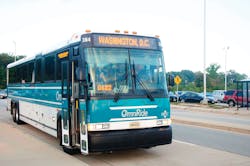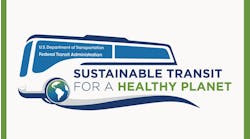Bus services operated by the Potomac and Rappahannock Transportation Commission (PRTC) transported nearly 3.3 million passengers in calendar year 2013, a 1.6 percent decrease compared with the previous year and the second year in a row that ridership declined.
PRTC provides commuter and local bus services for residents of Prince William County, Manassas and Manassas Park. In 2013, PRTC’s OmniRide and Metro Direct commuter bus services carried more than 2.2 million passengers, an average of about 9,500 each weekday, a 0.5 percent decrease compared with 2012. PRTC’s OmniLink and Cross County Connector local bus services transported just more than 1 million passengers, or about 4,000 daily, a 4.1 percent decrease compared with 2012.
Among the notable highlights for PRTC in 2013:
- A new Gainesville OmniRide route was started with direct service from the Cushing Road Commuter Lot to Washington, D.C.;
- Virginia Megaprojects gave PRTC funding to operate the Prince William Metro Direct bus service on Saturdays between eastern Prince William County and the Franconia-Springfield Metro Station from September 2013 to May 2014;
- Vanpool Alliance was created to increase the number of vanpools in the region through the collaboration of PRTC, the Northern Virginia Transportation Commission, the George Washington Regional Commission, and the Virginia Department of Rail and Public Transportation; and
- Wheels-to-Wellness was launched with funding from the Potomac Health Foundation to increase transportation options for medical-related trips for eligible applicants.
PRTC management attributes the overall ridership decline to several factors: the partial shutdown of the federal government in October, sequestration furloughs and a PRTC fare increase that took effect in July 2013.
“About 62 percent of PRTC’s commuter bus passengers are federal employees, and many others are government contractors, so sequestration furloughs and the partial government shutdown, which lasted for more than two weeks in October, had detrimental impacts on OmniRide ridership,” said Alfred Harf, PRTC executive director.
However, the federal government also was responsible for one positive influence in 2013 — the maximum allowable federal transit commuter benefit was increased for the calendar year from $125 to $245 monthly.
“That surely induced more OmniRide usage than would have occurred otherwise, lessening the impact of the other factors affecting ridership for the year,” Harf said.
Unfortunately, the allowable commuter benefit dropped back to $130 monthly as of January 1, 2014, though some in Congress are seeking to restore the higher benefit.
The fare increase that took effect on all PRTC bus services in July 2013 also played a part in the ridership decline. It was the first PRTC bus fare change in three years, but fare increases invariably reduce ridership. The OmniRide SmarTrip card fare increased to $5.75 per trip from $5.25, while the Metro Direct SmarTrip fare increased to $2.90 from $2.65. On local buses, the fare increased to $1.30 from $1.20.
Overseeing PRTC in 2014 will be a newly-appointed Executive Board. The officers are:
- Chairman Michael C. May, Vice Chair of the Prince William Board of County Supervisors;
- Vice Chairman Francis C. Jones, Mayor of Manassas Park;
- Secretary Robert Thomas, a member of the Stafford County Board of Supervisors;
- Treasurer Gary F. Skinner, a member of the Spotsylvania Board of County Supervisors;
- Immediate Past Chairman John D. Jenkins, a member of the Prince William Board of County Supervisors;
- At-Large Member Matthew J. Kelly, a member of the Fredericksburg City Council; and
- At-Large Member Jonathan L. Way, a member of the Manassas City Council.



